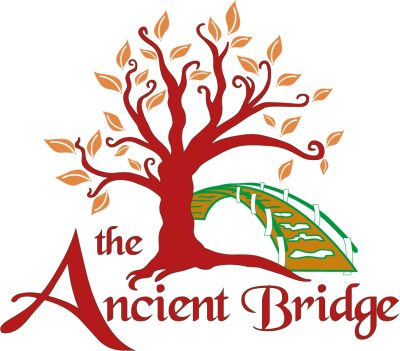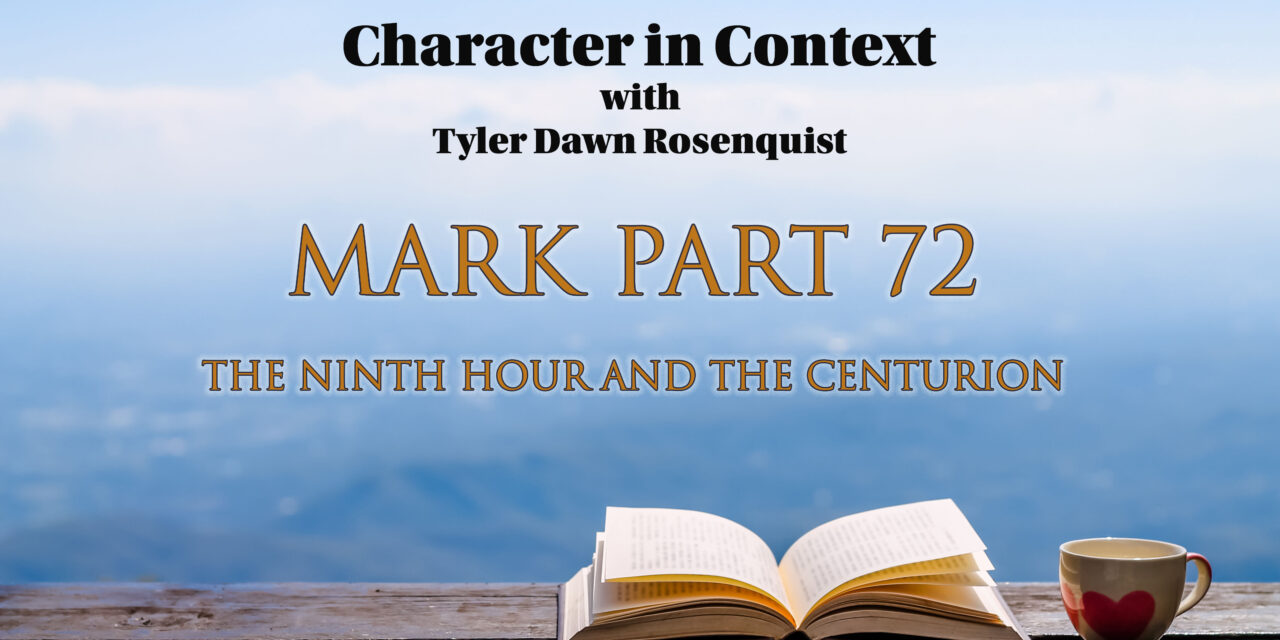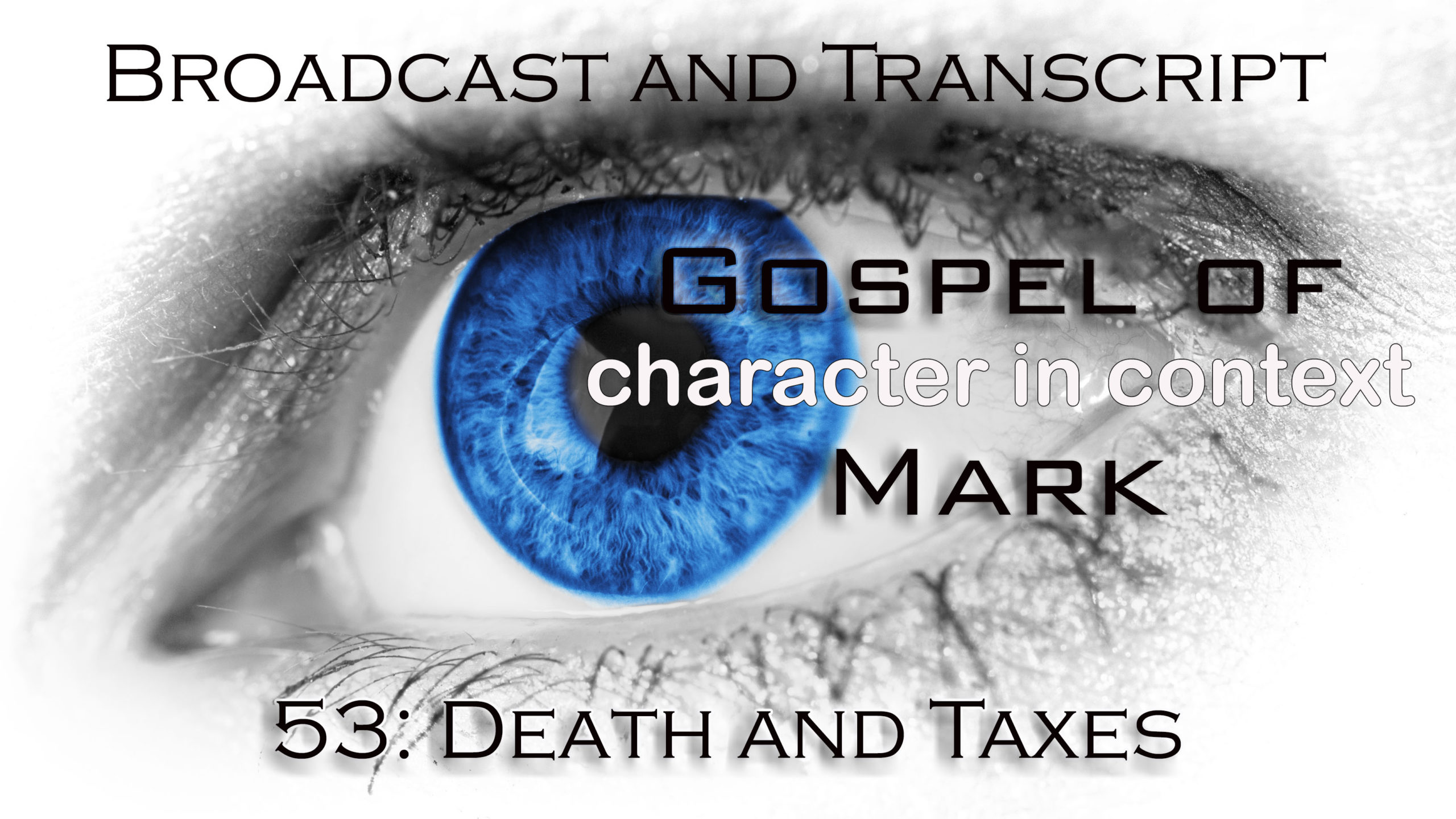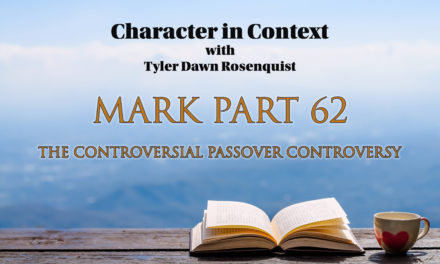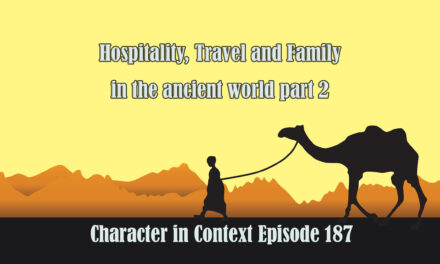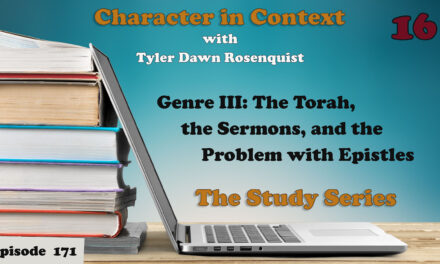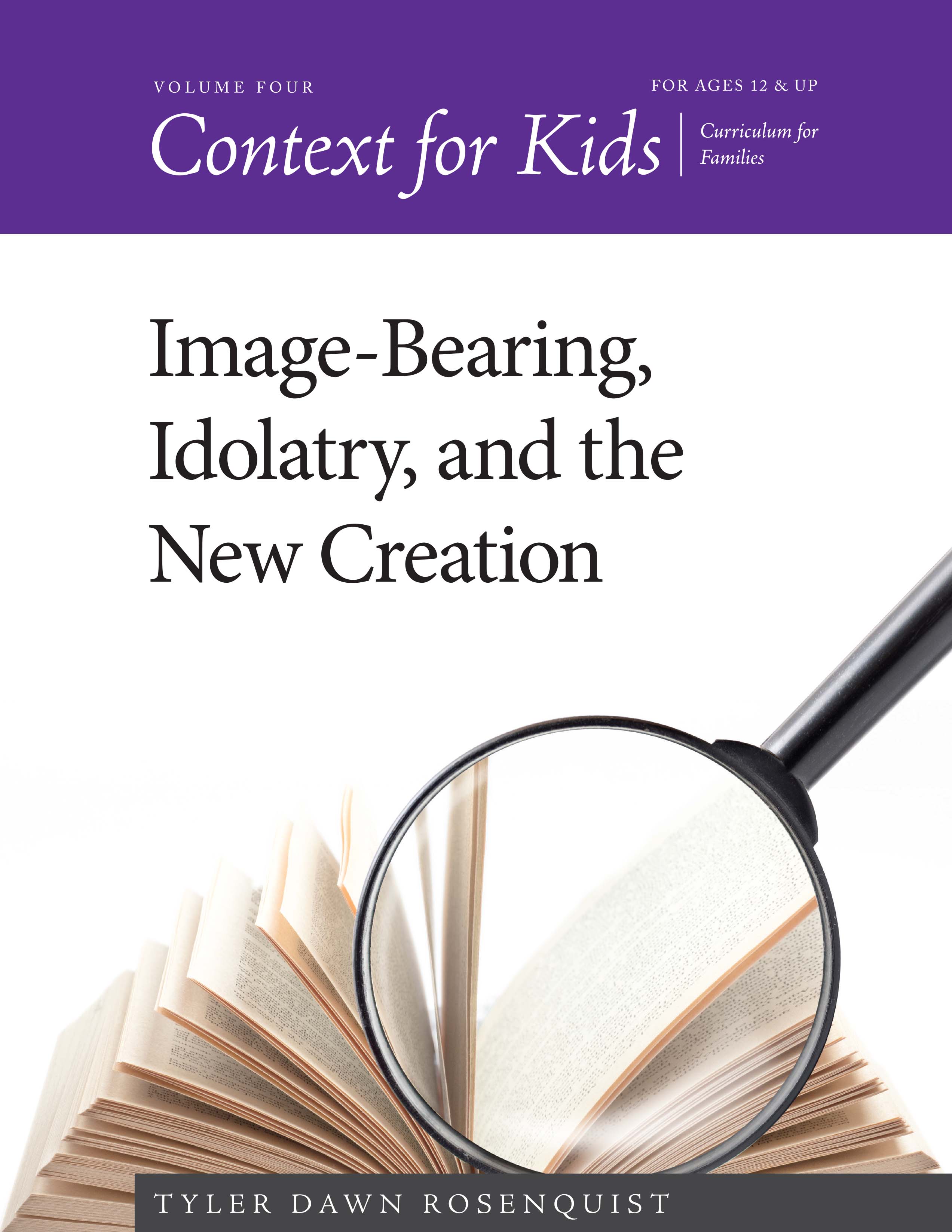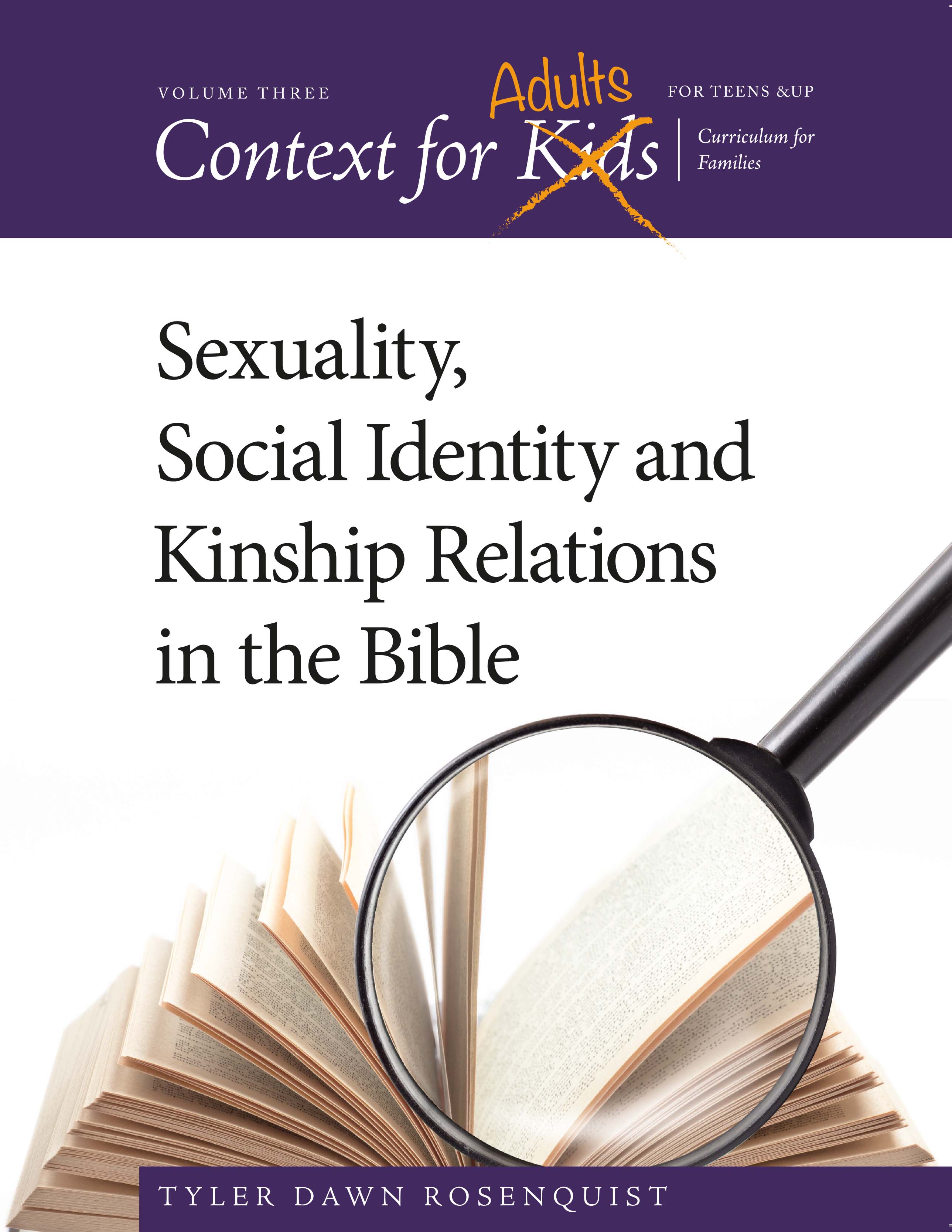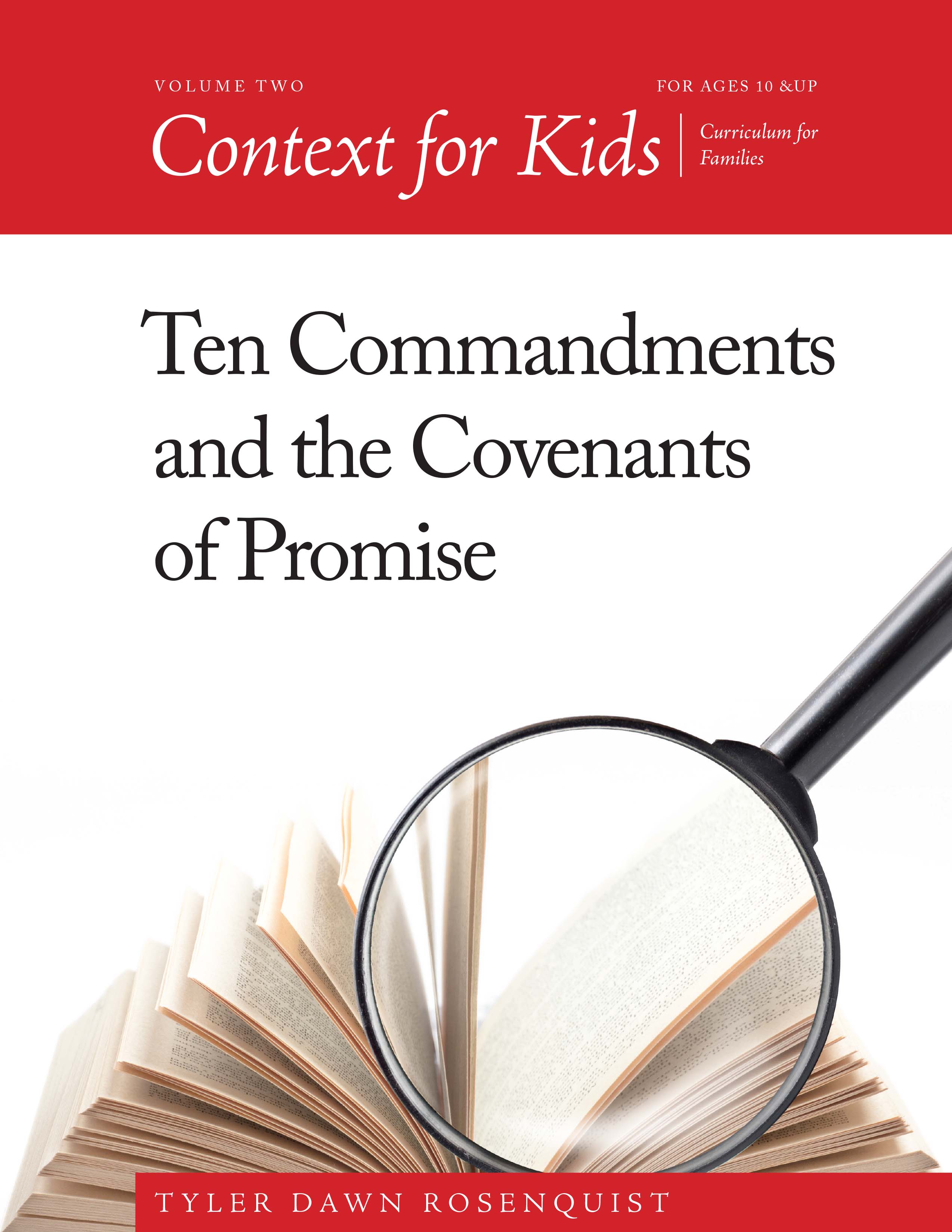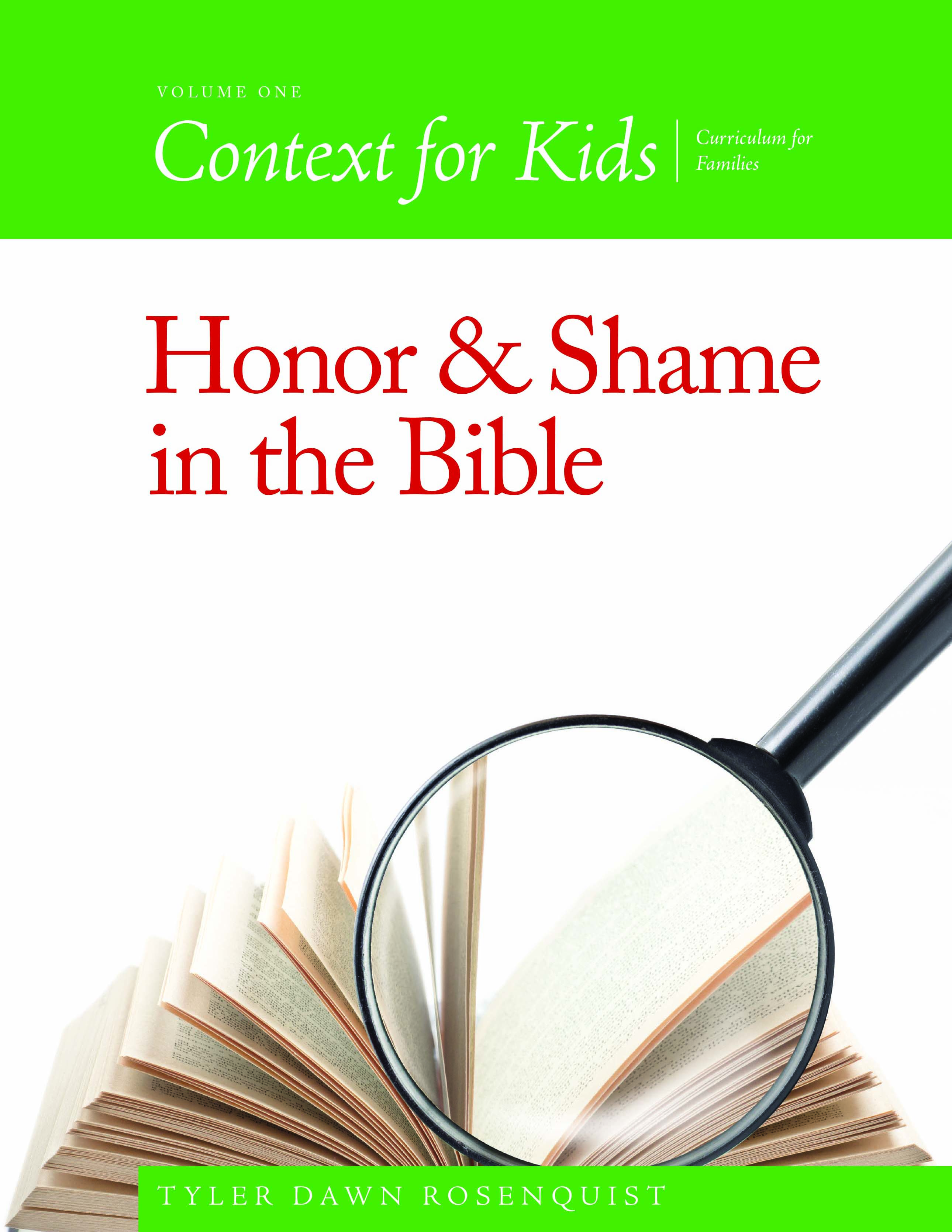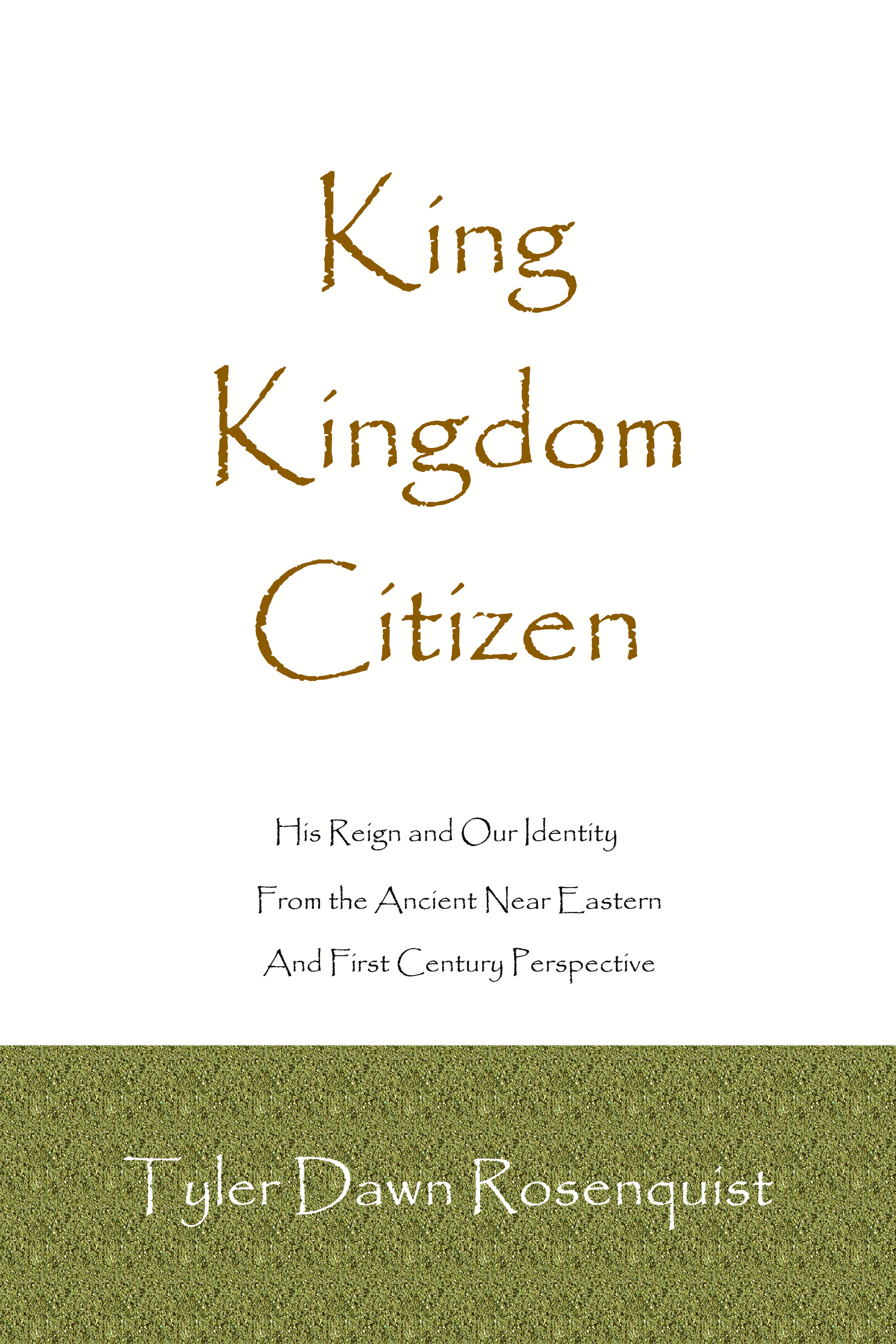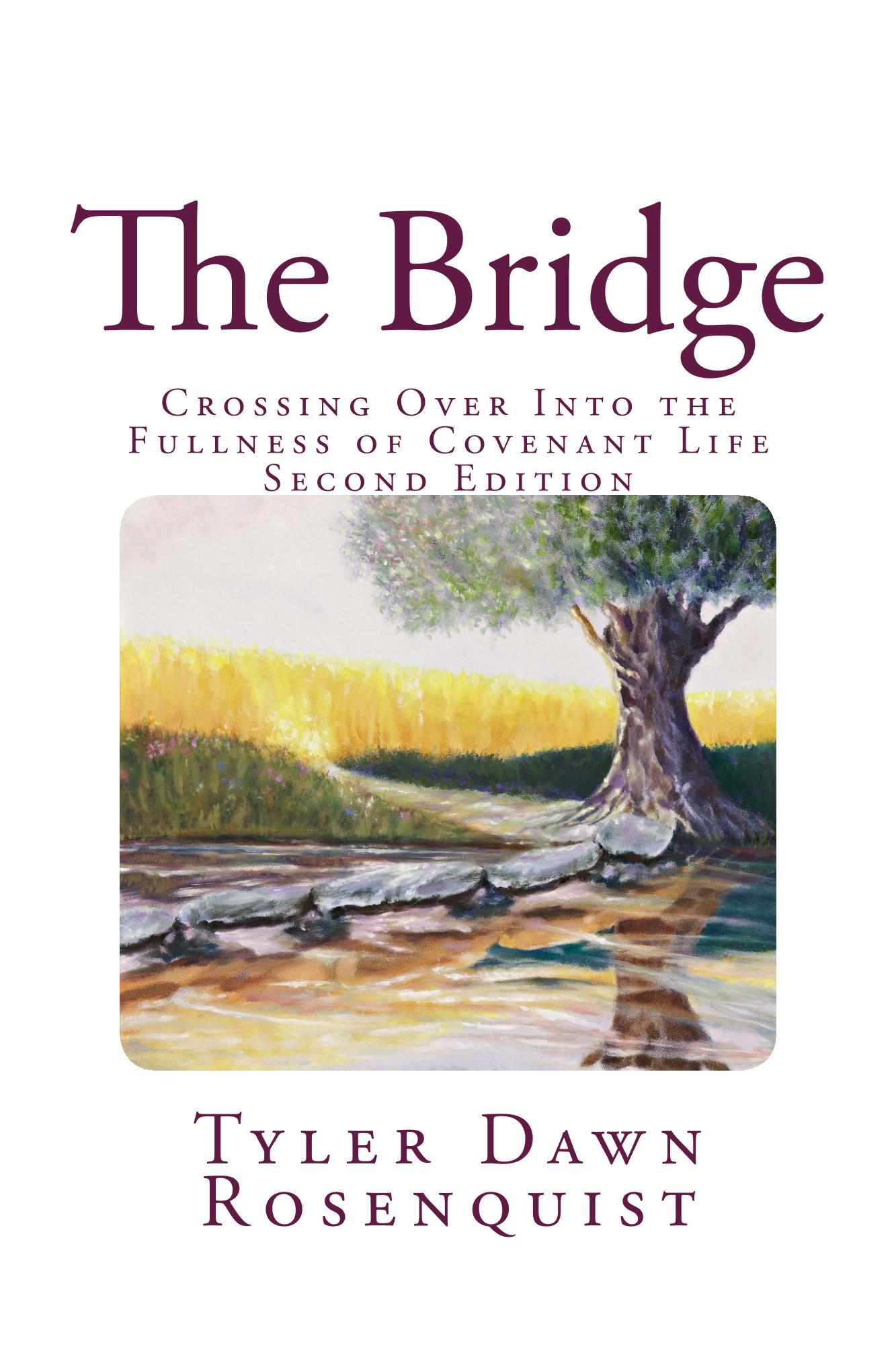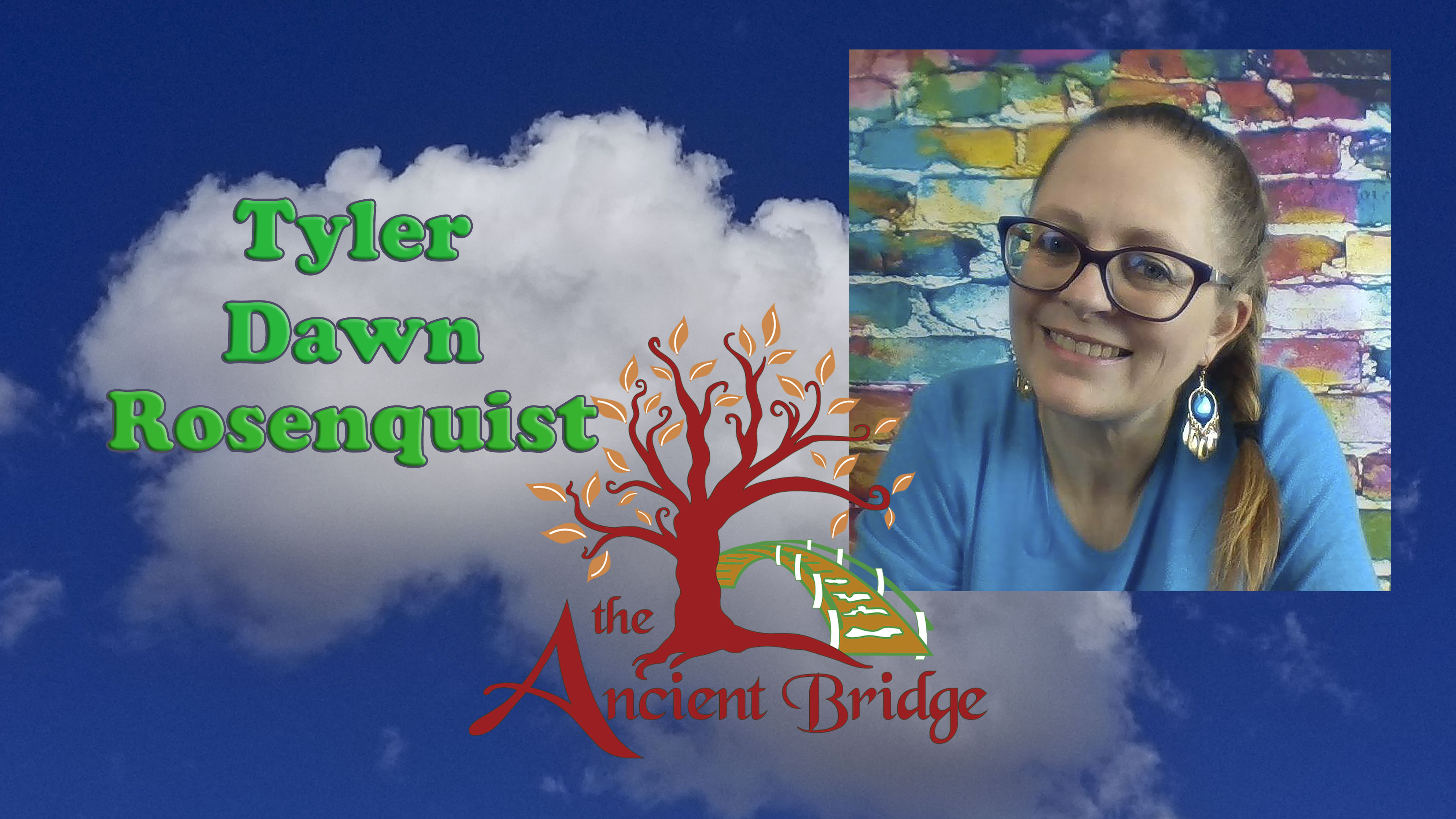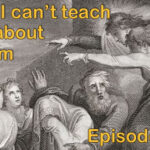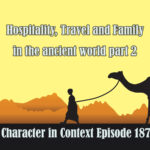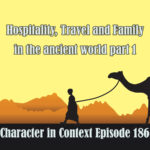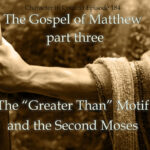There is far more to the account of Yeshua’s/Jesus’s death than meets the eye. We’re going to be talking about the Tamid offerings and their timing, the cosmic event language in Matthew and Mark concerning the darkness and the torn veil, and the importance of the Centurion’s declaration that, “Truly this man was the Son of God!”
(My affiliate links for Amazon products are included in the post. As an Amazon Associate, I earn from qualifying purchases.)
If you can’t see the podcast player, click here.
33 And when the sixth hour had come, there was darkness over the whole land until the ninth hour. 34 And at the ninth hour Jesus cried with a loud voice, “Eloi, Eloi, lema sabachthani?” which means, “My God, my God, why have you forsaken me?” 35 And some of the bystanders hearing it said, “Behold, he is calling Elijah.” 36 And someone ran and filled a sponge with sour wine, put it on a reed and gave it to him to drink, saying, “Wait, let us see whether Elijah will come to take him down.” 37 And Jesus uttered a loud cry and breathed his last. 38 And the curtain of the temple was torn in two, from top to bottom. 39 And when the centurion, who stood facing him, saw that in this way he breathed his last, he said, “Truly this man was the Son of God!” 40 There were also women looking on from a distance, among whom were Mary Magdalene, and Mary the mother of James the younger and of Joses, and Salome. 41 When he was in Galilee, they followed him and ministered to him, and there were also many other women who came up with him to Jerusalem.
So last time, we covered the concept of hours and how they were based on the position of the sun in the sky and not according to a set timekeeping system like we have now, with their daytime hours being longer in summer and shorter in winter and the opposite being true for the nighttime hours. And I told you that this week we would be talking about the apocalyptic, cosmic language of this section and why that was so important and what it would have communicated to the author’s Rome-based audience. We have the top slice of bread on this Markan sandwich with the Centurion’s declaration, and the shocking (to them) mention of the women who stayed by Him and were His followers all along, despite no one mentioning it until just now and we will talk about why that is so significant and in a few weeks, we will see what this mention is all leading to in the scandalous climax to the story.
Hi, I am Tyler Dawn Rosenquist and welcome to Character in Context, where I teach the historical and ancient sociological context of Scripture with an eye to developing the character of the Messiah. If you prefer written material, I have six years’ worth of blog at theancientbridge.com as well as my six books available on amazon—including a four-volume curriculum series dedicated to teaching Scriptural context in a way that even kids can understand it, called Context for Kids (affiliate link) and I have two video channels on YouTube with free Bible teachings for both adults and kids. You can find the link for those on my website. Past broadcasts of this program can be found at characterincontext.podbean.com and transcripts can be had for most broadcasts at theancientbridge.com. If you have kids, I also have a weekly broadcast where I teach them Bible context in a way that shows them why they can trust God and how He wants to have a relationship with them through the Messiah.
All Scripture this week comes courtesy of the ESV, the English Standard Version but you can follow along with whatever Bible you want. A list of my resources can be found attached to the transcript for Part two of this series at theancientbridge.com.
Review from the last few weeks (1) Yeshua/Jesus was replaced as the main character during the trial with Pontius Pilate the Procurator (according to Tacitus) or Prefect (according to Josephus and the inscription unearthed in 1961) but in the Gospel of Mark he is called the hegemoni. In reality, there isn’t much difference so don’t let the different terms confuse you. From there, we come across various groups who become the center of the action, all described as “they”—the soldiers, the ones who tried to give Him a narcotic in His wine (possibly the wealthy women of Jerusalem who were said to have done this for the condemned), the pilgrims walking by on the roads from Bethlehem and Joppa, the chief priests and their scribes, and the two lestes, social revolutionaries, who were crucified alongside Him. The actions of the world are now completely in focus and Yeshua has become nothing more than the direct object of their actions. He has become all but inanimate, a background character; (2) According to Joan Taylor, an expert in this field, Yeshua was right outside the Genneth Gate, outside the gates as claimed in Hebrews 13:12, and the chief priests were in attendance making sure that the pilgrims coming into the city on both roads were being inundated with the propaganda of why He deserved this and the Judeans coming in from their homes were evidently eating it up because Yeshua’s ministry was in Galilee and He would not be well known in the south; (3) Yeshua’s crucifixion happened at the third hour, which was the time when the morning Tamid offering was slaughtered in the Temple, and the morning Shacharit prayers were going up—one of which was a request for the offspring of David to be exalted, and soon; (4) Yeshua has now suffered through five mockings—by the chief priests and their scribes, by the centurions, by the festival pilgrims passing by, by the chief priests and scribes again, and by those crucified alongside Him. From top to bottom socially, from Jew to Gentile, and even the criminals, Yeshua is symbolically denounced by the entire world—almost. Let’s get to the text, starting in verse 33 of Matthew 15:
33 And when the sixth hour had come, there was darkness over the whole land until the ninth hour.
Now, the six hour is what we would call noon but in reality, would be anywhere from like 11:30 to 1:30, and on the Passover, it was somewhere around 12:30pm, so if someone says noon, they aren’t really that far off. Daylight hours are about 65 minutes long in Israel during that time of year, at Passover. This was the time in the Temple where the evening Tamid was brought out and the afternoon prayers began, but the afternoon Tamid offering was not slaughtered until the ninth hour. This is obviously very important to Mark’s narrative in equating Yeshua not only to the Passover but to both Tamid offerings, aka the continual offering that burned all day and all night every day. Mark is very adeptly portraying Yeshua as the substance of both the daily and the festival offerings. But unless we study the Temple in depth through extra-biblical sources, we totally miss it. These hours are not to be found in the Torah, or the minutiae of Temple procedures. A very useful study course on this, that I went through years ago and it took me a few years of in-depth study, is www.jerusalemtemplestudy.com and the teachers are my wonderful friends Joseph Good and Edgar Ramos. It’s so easy to get things wrong when we don’t know the Temple and the many kinds of sacrifices and their accompanying drink and grain offerings–it is a very complex subject. No one can just read Scripture and get it because the ancient Near Eastern context of things like appeasement, blood rituals, leaven, the concept of drawing near, and so many other things are not in the text in any obvious way to our modern eyes and some things aren’t there at all and have only become understood through archaeology. We can know how and why they did just about everything, but we can’t learn it from the Bible.
So, we have the sixth hour, when the afternoon Tamid lamb was brought out for display, and an unnatural darkness came over the “whole land.” This darkness is very important. This was not a solar eclipse as the moon would have been on the wrong side of the earth at that point in time. You can have a lunar eclipse at the Passover, but not a solar eclipse because that is the time of the month where the moon is entirely or almost full. It is simply astronomically impossible because the moon must pass between the earth and the sun but that time of the month it is not possible. So, what is this darkness? For that we have to look at the Hebrew Scriptures and cosmic symbolism. At creation, the darkness was separated from the light and it was called good, and so on one level here, we have the beginning of a cosmic reset. Yeshua rested in a garden tomb, representing the second and third days of Creation when the land appeared and green things grew, and on the third day He rose, representing the creation of the sun, moon and stars. Whether this really happened or Mark was simply expressing the event in terms of apocalyptic eschatology is unknown. If it didn’t happen, it doesn’t matter because, like Matthew’s account of the earthquake and the graves coming open, this communicated literary truths about what was happening in the world and to the world and behind the cosmic veil, when Yeshua was crucified. I know that might disturb some folks who want everything to be literal, but this was what made sense to them so we have to play by their rules. These people knew when and when not to expect eclipses, and if it went dark unexpectedly there would have been panic, which wasn’t mentioned. But if Mark is expressing a rebooting of Creation, this is the exact kind of symbolism he would use.
Darkness is often a cosmic event in the Bible—whether it be referring to the chaos before Creation, or judgment, as in the ninth plague against Egypt: 21 Then the Lord said to Moses, “Stretch out your hand toward heaven, that there may be darkness over the land of Egypt, a darkness to be felt.” 22 So Moses stretched out his hand toward heaven, and there was pitch darkness in all the land of Egypt three days (Ex 10). We also see darkness in the story of Abram, when a “great and horrifying” darkness came over him in a supernaturally induced sleep. I make mention of this because this, in Gen 15, marks the very cosmic event of the Covenant of the Pieces, where Yahweh made a very specific kind of covenant with Abram. In the ancient Near East, two people or two groups would cut animals down the middle and place the halves on either side of an open area, and the participants would walk in between those animals and they would swear, “May whoever breaks the words of this covenant suffer the same fate as these animals!” But in this case, Abram was asleep and He watched as an smoking fire pot and a blazing torch passed through the pieces as God promised Abram and his descendants the Land of Israel.
Yahweh would again appear to the children of Israel in the form of fire and smoke as they passed through the halves of the Yam Suf, sometimes popularly translated as Red Sea, and through the wilderness journeys. The presence in the form of fire and smoke was an ongoing reminder of Yahweh’s promise to deliver them into the promised Land. But you might ask what that has to do with this? Remember that Mark has been building up to the second and greater exodus all this time, Isaiah’s “new exodus” led by Yahweh Himself. The Israelites were perennially unfaithful to the covenant, but only Yahweh passed through the pieces in the form of the Angel of the Lord, whom we know to be Yeshua. Yahweh is the only one who can redeem His people and deliver them from the Pharaoh of sin and death and into the promised Land of the New Creation. And so right before the death of the firstborn, the tenth plague on the very night of Passover, we see that motif of absolute darkness over the whole land. The original Passover is becoming the greater Passover, and the first Exodus is making way for the Greater Exodus, the daily Tamid is only a shadow of the eternal Tamid, and the salvation of the few is becoming the salvation of the world, and the Temple of Jerusalem will be replaced with a worldwide Temple of living stones. Yeshua’s Passover is greater. His Exodus is greater. His salvation is greater. His Temple is greater. His sacrifice will be greater.
34 And at the ninth hour Jesus cried with a loud voice, “Eloi, Eloi, lema sabachthani?” which means, “My God, my God, why have you forsaken me?”
At the ninth hour, Yeshua breaks His silence in a loud voice that must have shocked the bystanders. In fact, the word for “cried” here is the same word used to describe John the Baptist crying out in the wilderness. We are beginning and ending the story of Yeshua with a crying out. That’s not coincidental. As the afternoon Tamid was brought to the north of the altar and prepared for slaughter, Yeshua speaks in Aramaic the first verse of Psalm 22: “Eloi, Eloi, kema sabachthani?” which the author then translates because his audience is Roman and even the Jews in the congregation would more likely speak Greek than Aramaic. For those who claim Aramaic primacy on all NT documents, it just doesn’t make contextual sense as so many of the writings were for Gentile believers throughout the Empire. Does He say this as the darkness breaks? It doesn’t say, or do His words themselves break the darkness? That seems more likely to me. He is, after all, the Word of God through whom all that was created was created, according to John. His voice, therefore, separates light from the darkness. Again, this is a cosmic event, the second we have seen this week. First the darkness falls over the whole land, as it did in Egypt when Pharaoh was judged, and then the voice of Yeshua breaks the darkness and brings out the light again as at Creation.
And people say that Yeshua is quoting Psalm 22:1 in order to be symbolic but He is in the midst of drinking the cup of wrath. If He was in agony and torment in the Garden, so much that He was barely functional, how is He better off now or how is He logically plotting out what He should say in order to make an “aha” point? I believe this is a genuine crying out. He cries out to God and not to Father, as He normally did. I don’t think Yeshua planned this any more than the soldiers planned to fulfill Ps 22:16-18, or the crowd planned to fulfill Ps 22:6-8. This is prophecy being played out, not in a contrived way but instead as prophecy always plays out—in fulfillment of something that could never have been predicted beforehand. Remember, when we studied Isaiah, I told you that predictive prophecy isn’t given to us so that we can know ahead of time what till happen. It is given to us so that after it comes to pass, we can say, “Aha! Look at the glorious works of Yahweh! Can any other god give us the future before it happens??” Predictive prophecy was for the glory of Yahweh and as witnesses of His power. No one could have ever predicted that Psalm 22 would play out as it did. And the most heartbreaking thing of all is that Yeshua receives no answer whatsoever. All of those things He said about being handed over, paradidomi, the Septuagint word for God handing His people over to the Gentiles (usually) for discipline, have come to pass.
35 And some of the bystanders hearing it said, “Behold, he is calling Elijah.”
What we do not know here is if they are serious or mocking Him. Later Rabbinic legends have Elijah coming to earth disguised as an angel and saving people, most notably renowned teachers in peril. Were these legends in circulation at this time? No way of really knowing. Or were they hypothesizing about the words of the prophet in Malachi 5? 5 “Behold, I will send you Elijah the prophet before the great and awesome day of the Lord comes. 6 And he will turn the hearts of fathers to their children and the hearts of children to their fathers, lest I come and strike the land with a decree of utter destruction.” After all, if the sky had gone dark for three hours, and Yeshua had worked many amazing miracles—and even if they wanted to at this point, no one can get Him down off the Cross because the Romans would kill (or worse) anyone who tried. This has gone past the point of no return. No one can stop this except God at this point, or His agent Elijah who could call down fire and kill every Roman in the city. Of course, we know that Elijah had already come (despite the claims of twelve people who have sent me friend requests on social media that they are Elijah), as Yeshua had told the Twelve in chapter nine: 11 And they asked him, “Why do the scribes say that first Elijah must come?” 12 And he said to them, “Elijah does come first to restore all things. And how is it written of the Son of Man that he should suffer many things and be treated with contempt? 13 But I tell you that Elijah has come, and they did to him whatever they pleased, as it is written of him.” Not only have the crowds missed the Messiah, they have also missed the forerunner. Ironically, the bulk of Judaism is still waiting for both Messiah and Elijah. I am certain that Paul and the other apostles never dreamed it would still be this way. But, it is changing all the time.
36 And someone ran and filled a sponge with sour wine, put it on a reed and gave it to him to drink, saying, “Wait, let us see whether Elijah will come to take him down.”
Psalm 69 is another Messianic Psalm, the one where we see the phrase “zeal for your house has consumed me”, and verse 21 mentions sour wine, “They gave me poison for food, and for my thirst they gave me sour wine to drink.” According to Plutarch in Cato Major I.3, sour wine was the Gatorade of the ancient world (full disclosure, he didn’t mention Gatorade). In fact, it was the common drink of soldiers because the water they had access to was really undrinkable on its own. You know it’s bad when vinegar makes the water taste better. The word for reed is kalamos, the same as the word used for whatever it was that the soldiers were hitting him with. Remember that Yeshua would only have been about seven feet off the ground and so the reed would not have to be enormously long to reach his mouth, unless they were treating Him as more of a celebrity and then perhaps they used a taller post. The paintings obviously wanted him up higher and more prominent but from what Mark has said, we really are not privy to that information. So, the sour wine would presumably not be an act of mercy but a way of energizing Yeshua in order to give Elijah more time to show up, if they were serious, or as another form of mocking—but of course, John the Baptist was dead as well and would not be showing up.
37 And Jesus uttered a loud cry and breathed his last.
This would have been shocking to the Roman soldiers, who had seen crucifixions all their lives. As children they would have passed by crucified bodies from time to time, it was appallingly normal. The victims would slowly suffocate or fade away from blood loss or dehydration. But this is not what happened. Six hours on the Cross, and before that a brutal scourging over every surface of his body. It was roughly 4:30 in the afternoon and He had not eaten or drank anything since at least midnight, and he hadn’t slept in at least thirty-two hours. The word for loud cry is the same as loud voice in verse 34. How can it be possible for a man who was about to breathe His last breath, that He could manage to cry out loudly and coherently not once but twice? This death was both unexpected and violent and preceded by a show of strength and power. It was as though He died but wasn’t defeated—they didn’t get to watch Him slowly linger and waste away. This will be important when we come to verse 39 and is often missed.
38 And the curtain of the temple was torn in two, from top to bottom.
The Talmud does record some things that happened forty years before the destruction of the Temple, but this was not one of them. There are a number of possible reasons for this, but first let’s look at what they admit did happen: “The Sages taught: During the tenure of Shimon HaTzaddik, the lot for God always arose in the High Priest’s right hand; after his death, it occurred only occasionally; but during the forty years prior to the destruction of the Second Temple, the lot for God did not arise in the High Priest’s right hand at all. So too, the strip of crimson wool that was tied to the head of the goat that was sent to Azazel did not turn white, and the westernmost lamp of the candelabrum did not burn continually. And the doors of the Sanctuary opened by themselves as a sign that they would soon be opened by enemies, until Rabban Yoḥanan ben Zakkai scolded them. He said to the Sanctuary: Sanctuary, Sanctuary, why do you frighten yourself with these signs? I know about you that you will ultimately be destroyed, and Zechariah, son of Ido, has already prophesied concerning you: “Open your doors, O Lebanon, that the fire may devour your cedars” (Zechariah 11:1), Lebanon being an appellation for the Temple.” (Yoma 39B, Sefaria.org)
So, what did happen? One, the curtain might not have torn—and besides that we don’t even know if this is referring to the inner or outer curtain. This might be more cosmic language, as with the darkness falling but everyone not going into a total panic, and would communicate that the barrier between heaven and earth was eradicated and replaced with Yeshua, who is a mediator and not a separating force (not to be confused with the wall of separation around the Temple complex which kept the Gentiles at a distance from the Azarah, the 500×500 amot (royal cubit which was quite larger than the standard 18” cubit) raised platform on which Solomon’s Temple, Palace, and the House of the Forest of Lebanon were all built.) To the audience, who were very familiar with the concept of holy space (Jew or Gentile made no difference in this), and who would understand that the curtain, whichever one it was, was in place to both protect the presence of God from defilement and the people from encroaching on sacred space and dying. The curtain itself was incredibly thick, woven on a special loom and I believe it was as thick as the width of a man’s hand, been a while since I studied that out. Obviously impossible for a person to tear it or even a team of oxen. This would have to be an act of God but when we look at this as a cosmic act, it is as though the fabric of reality has been torn and I wish I could remember who said that because it’s really epic. I don’t take great notes.
Yeshua shouts in a shocking show of strength and the curtain in the Temple tears in two, not from bottom to top but from top to bottom. Something I never noticed until studying the commentaries was that, like the Covenant of the Pieces and like the parting of the Red Sea and the division of light and darkness, we have another separation text. There are things in this world that should and should not be divided. Things that were meant to be divided and things that were meant to be together. God’s creational intent, how things were in the beginning, shows a separation between light and darkness, land and sea, and the heavens above and the earth below. These are functional and needful separations. Then we have things that should never have been separated—God from humanity in the Garden, men and women from each other when their mutuality became fractured in the aftermath of sin, and God’s people from each other. But our rebellion separated us from God, and also fractured the equality men and women shared in the Garden, and our stupid pride separates us from each other over so many ridiculous reasons now. Case in point, did you know that the early church was the western church, the eastern church, and the African church? Africa had an amazingly vibrant church full of great thinkers like Augustine, Athanasius, and many others but because of differing cultural outlooks, they saw certain things differently and divided. As a result of that, when Islam rose up, the African church was left abandoned and was destroyed. And that’s a crime. What a different world it would have been if they were all just content to be united in Christ and Him crucified!
39 And when the centurion, who stood facing him, saw that in this way he breathed his last, he said, “Truly this man was the Son of God!”
Could Yeshua or the Centurion see the curtain? Could anyone in the Temple see Him? Nope. The Temple faced toward the east and was surrounded by very high walls and although one could look down into it from the Mount of Olives, that wouldn’t have been a logical site for a crucifixion. Ernest Martin says otherwise but he is a widely known fraud by the archeological community and those who actually study the Temple. He claims conversations he supposedly had with people who are dead and can’t verify it, and whose families say is impossible. Just, no. And his City of David Temple would only work if the cubit was like 6” and the Temple was teeny weenie. His books are popular with people who have not studied the Temple and the archaeology in depth—and with those who have never studied Josephus who in Wars really makes it clear that Martin’s theories are impossible.
Matthew says he saw the earthquake and made his proclamation based on that. Mark says that he based his proclamation on how Yeshua breathed his last. Luke talked about Yeshua’s loud proclamation before dying. None of the texts claim that the Centurion saw the veil torn in two. Yeshua was on the other side of the city, in a place where people could pass by on roads without needing to come into the area where they could develop corpse impurity. If you haven’t read Joan Taylor’s excellent scholarship on this, it’s in the last two transcripts. If Yeshua was facing the Temple, on the Mount of Olives, and the Centurion was facing Yeshua, then the Centurion would not witness the tearing of the veil anyway. In fact, even if the Centurion was facing the Temple Mount and was looking down (and not doing his job) he would not see the veil at all if it was the inner veil and wouldn’t probably be able to get a good look at it if it was the outer veil either. Once you got high enough up to see the Temple, you would absolutely marvel in its beauty but what you would be able to really focus on would be limited.
But, before we move on, let’s remember the Markan sandwich here. The centurions were mocking him and calling Him King of the Jews, remember? And then there was the actual crucifixion and now that Yeshua is dead, this Centurion is calling Him the Son of God, which is a very meaningful phrase to the Romans. So, what happened in between that made Yeshua Son of God in the eyes of the Centurion and no longer an object of scorn? What happened in between, and that’s why it is called a Markan sandwich because you have two bookends that need to be interpreted by what goes on between them. In this case, everything that Yeshua endured, for our sake, is what truly makes Him King, the Son of David, the Son of God, the Messiah. But for the Centurion to use this specific language is huge. Ever since the deification of Julius Caesar, post mortem—meaning after he died—the reigning Caesar was dubbed divi filius on the coins of the Empire, and divi filius means “son of god.” Which is kind of ironic because the Caesars never made their own sons their heirs, they would adopt a nephew or something like that and it was perfectly legal to do so. And really probably a better idea than just doing the first born son thing which can go really wrong. But for a Centurion to say this would have been sedition, giving an Imperial title to a crucified Jew. If anyone overheard him, he’d be up on the next cross if he wasn’t a citizen yet. And since it took 25 years for a soldier to earn citizenship, it wasn’t likely. This marks a change of allegiance of sorts and is meant to foreshadow the salvation of the Gentiles, as the first to acknowledge Him wasn’t just any Gentile but one of His executioners. And given the gods of the pagan world and especially those of the Romans, this would have been a terrifying prospect. He would have believed in regional gods and they just killed the son of one. So, that’s the first unexpected plot twist.
40 There were also women looking on from a distance, among whom were Mary Magdalene, and Mary the mother of James the younger and of Joses, and Salome.
Here is the second unexpected plot twist. Remember how the author framed the scene as though the forces of the evil one, the powers and principalities, have marshalled their forces against Yeshua, both Jew and Gentile, and that Yeshua is just this background character and the world has taken center stage in destroying Him. And it has appeared that He is entirely on His own. His followers have abandoned Him. His biological family is nowhere to be found. His childhood friends are absent even though all these groups are in town for the Passover. Everyone is there, they just aren’t standing by Him. Except. Except a group of women, among whom (in other words, not limited to) Mary from Magdala, Mary the mother of James (Jacob) and Joses (Joseph), and Salome. How come these women who have never been mentioned all this time are suddenly brought to the forefront only once Yeshua is dead? I mean, this is odd because Mark hasn’t mentioned women very often, unlike Luke in his account.
Why were they at a distance? Was it fear of the soldiers, that they would be molested? Was it perhaps because Yeshua was stripped naked and they stayed far enough away for modesty’s sake? If you remember in chapter 14 that Peter followed Yeshua from a distance as he was taken to the home of the High Priest, after having run away during the moment of crisis, and would later deny Him. All this despite proclaiming that he would die before abandoning Yeshua. Here we have the women who have been so quiet and unobtrusive this entire time, not calling attention to themselves or their works or demanding a seat at the table or high places in the Kingdom, and they haven’t abandoned Him. They can’t do anything except be there in solidarity as He suffers, and it would have been horrific to watch, but when we contrast the brash, arrogant, bragging and posturing of the Twelve and especially Peter with these women who were certainly less able to protect themselves than strapping, muscular young fishermen, it is just really very touching and profound.
I also want you to notice that there are three of them named, who remained faithful, who were with Him when He came into His Kingdom, contrasted with the “big three” James, John and Peter who assumed that those faithful to the end and rewarded for it would be themselves. This is calculated, not coincidental. The fabric of reality has torn and the least have become the greatest. The last have become first. And this was not something that would have added credibility to the account. This was a man’s world, entirely, women generally weren’t even allowed to be educated, which caused big problems in places like Ephesus.
Was Mary the mother of James and Joses also Jesus’s mother? Perhaps. Those were the names of two of His brothers, along with Jude (Judas) and Simon. At the very least James and Joses were known to the Roman church or else there would be no point in naming them like this. It’s the same thing as when Simon of Cyrene was pointed out to be the father of Alexander and Rufus. Mary from Magdala we don’t know from this particular Gospel, and in Luke we just get the very brief mention that she had seven demons cast out of her. What we know of her in the other Gospels is limited to her being the famous first witness in all accounts. Salome is not given any identifiers and so she must have been well known. No one would be named without being connected to someone else or somewhere else. No husband, sons or place of origin mentioned so it is likely that she was a woman who had her own household. But who are these women?
41 When he was in Galilee, they followed him and ministered to him, and there were also many other women who came up with him to Jerusalem.
Oh dear, they are disciples! Not among the Twelve but they followed Him and they also ministered to Him. No, this does not mean they were servants. Yeshua allowed women to learn from Him and we see too many women mentioned as early leaders of the church to just assume that they were cooking and cleaning. We know from elsewhere that these were women of means who supported them financially, with no husbands mentioned. They had been with Him since Galilee and followed and ministered to Him there and had come with the group of disciples to Jerusalem for the Passover. No way could an itinerant preacher and a former carpenter and a bunch of fishermen and other young men afford to do what they were doing without financial support. Perhaps they were even the wealthy women who offered Him myrrh-infused wine as a narcotic. But again, this was somewhat scandalous, to have women, unattached to husbands or sons, galivanting around Galilee with a bunch of men! The word here translated as ministered is the same word used to describe the activity of the angels on behalf of Yeshua as He was being tempted in the wilderness.
The Son of David. I want to bring up for a moment the difference in how women are talked about in the Gospels and treated by Yeshua than they are in the accounts of David. The women in the Gospel are followers, ministers, helpers, supporters, and witnesses. They are never spoken poorly of and they are never up to all the hierarchal nonsense of the Twelve. They never abandon Him. They show up to care for the body. They are the first evangelists. Perhaps they will even assist Joseph of Arimathea when he claims the body. But David? For David, women are there for his pleasure, for alliances, to leave behind to guard the palace when he is on the run, to be peeped at and sexually assaulted and deprived of husband. The fabric of reality has indeed been torn and the Kingdom of Heaven is here—Yeshua brings a whole new paradigm to the Davidic line.
Next week we will talk about whether or not Good Friday was actually on a Friday. It’s a sadly manufactured controversy that sounds good at first glance but not when we are aware of the historical and literary background.
